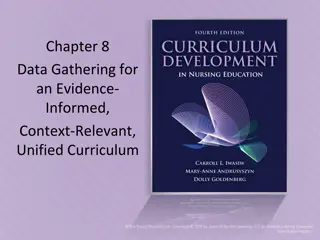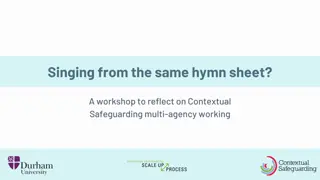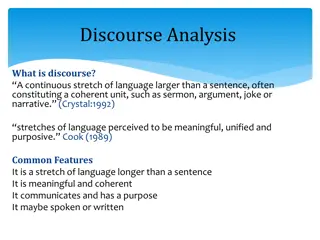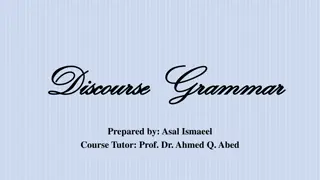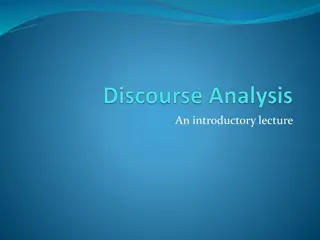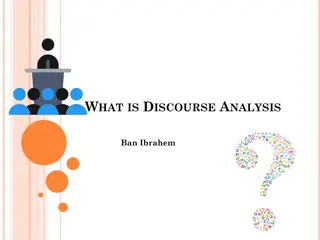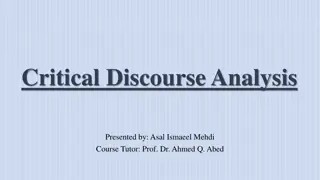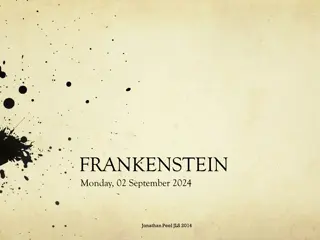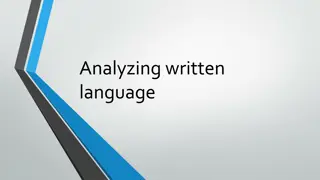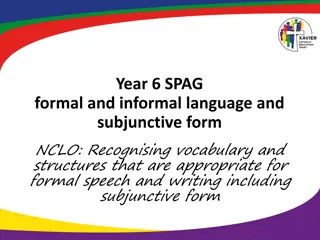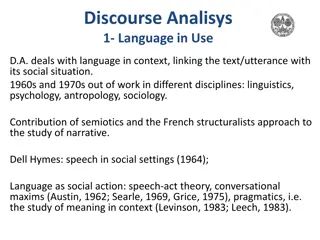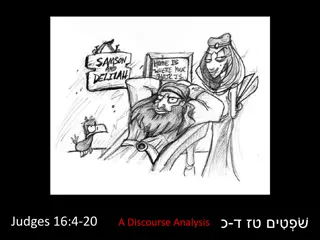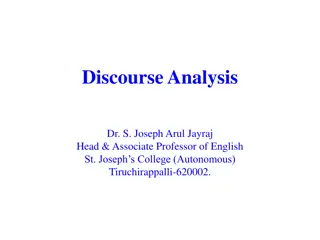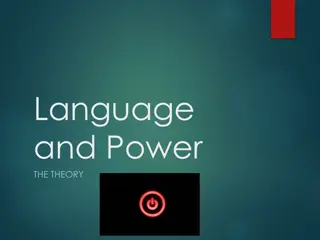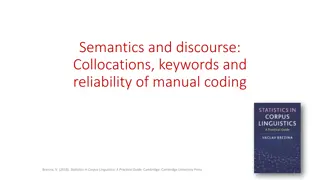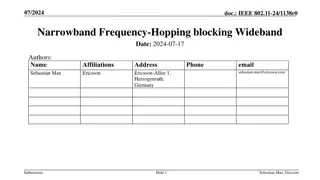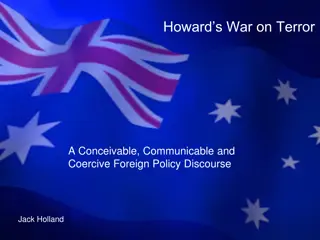Understanding Discourse Analysis: Formal Links and Contextual Connections
Discourse analysis involves examining language beyond grammar rules, focusing on formal links within sentences and contextual connections outside of language. Guy Cook discusses how formal features shape discourse meaning and how verb forms influence sentence coherence. The use of parallelism in speech, prayers, and poetry is also highlighted as a powerful emotional tool.
Download Presentation

Please find below an Image/Link to download the presentation.
The content on the website is provided AS IS for your information and personal use only. It may not be sold, licensed, or shared on other websites without obtaining consent from the author. Download presentation by click this link. If you encounter any issues during the download, it is possible that the publisher has removed the file from their server.
E N D
Presentation Transcript
Discourse analysis Chapter 2 Discourse analysis chapter 2 Formal links By Guy Cook 1980 Formal Links By Guy Cook 1989 1
FORMALANDCONTEXTUALLINKS In order to account for discourse we need to look at features outside the language. This fact enables us to construct stretches of language as discourse as having meaning and a unity for us. The way we recognize correct and incorrect sentences is different. We can do this through our knowledge of grammar without reference to outside facts. Cook states there are two ways of approaching language that one of them is formal links, referring to facts inside language. 2
A way of understanding may be to think of formal features as in someway built up in our minds from the black marks which from writing on the page or from the speech sounds picked up by our ears . while Contextual features are somewhere outside this physical realization of the language in the world or pre-existing in the minds of participants . Stretches of language treated only formally are referred to as text. Formal links between sentences and between clauses are known as cohesive devices . 3
Verb form The form of the verb in one sentence can limit the choice of the verb form in the next, and we may be justified in saying that a verb form in one sentence is wrong , or at least unlikely , because it does not fit with the form in another. 4
If we look back at the exchange between the piano movers example, we can see that the verbs ( s go in, s got to take , ain t go in , don t% come on) are all in the present since the verbs refer to general truth (although they refer to the future). There seems to be a degree of formal connection between them, a way in which the first tense conditions all the others, and it would be very strange if the exchange had been: A: Right, who s go in to lift the bottom? Well, someone had got to take hold of it. B: I shan t have been go in to. A: Don t . . . Come on will you? 5
PARALLELISM Another link deals with parallelism ,device which suggests a connection, simply because the form of one sentence or clause repeats the form of the another. This is can be found in speeches, prayer , poetry and advertisments. It is used to provide a powerful emotional effect to the audience. 6
Here, for example, is part of a Christian prayer: Teach us, Good Lord, to give and not to count the cost, to fight and not to heed the wounds, to toil and not to seek for rest, to labour and to ask for no reward, save that of knowing that we do Thy will. (St Richard s Prayer).This example employs parallelism to link clauses and there is repeated grammatical structure( to .. and not to..). 7
Parallelism which suggests a connection of meaning through an echo of form, does not have to be grammatical parallelism. It may be a sound parallelism: as in the rhyme, rhythm, and other sound effects of verse. One might even extend the idea and talk of semantic parallelism where two sentences are linked because they mean the same thing. 8
REFERRINGEXPRESSIONS These are words whose meaning can only be discovered by referring to other words or to elements of the context which are clear to both sender and receiver. The most obvious example of them is third person pronouns (she/her/hers/herself, he/him/his/himself it/its/itself; they I them! their I theirs !them selves). 9
If we are listening to a story and somebody says So I ate it we may well know the meaning of it from somewhere earlier in the story. We choose the most likely meaning for it from the text. It is important to notice that our knowledge of the meaning of it is only partly formal though. It involves our knowledge of the world as well, and if the story had gone There was a pineapple on the table. So I ate it. In an extended piece of discourse, a common procedure, known as anaphora, is for the identity of someone or something to be given once at the beginning, and thereafter referred to as she or he or it. This makes a kind 10
of chain, running through the discourse, in which each expression is linked to another: a pineapple ... it ... it ... it .. . It is not only third person pronouns which work in this way. The meanings of this and that, and here and there have also to be found either formally in another part of the discourse or contextually from the world. Referring expressions fulfil a dual purpose of unifying the text (they depend upon some of the subject matter remaining the same) and of economy, because they save us from having to repeat the identity of what we are talking about again and again. 11
Sometimes the chain has to be followed in the opposite direction. We are given the pronoun first, and then kept in suspense as to its identity, which is revealed later. This is known as cataphora, and it is a favourite opening device of authors who begin stories and novels with an unidentified he or she, both enticing us to look further, and plunging us into the middle of a situation as though we already knew what was going on. Again, this device seems to be one which children can handle quite early. 12
REPETITIONANDLEXICALCHAINS Repetition of words can create the same sort of chain as pronouns, and-., there are sometimes good reasons for preferring it. In Britain, mother tongue learners of English are discouraged from using repetition on the j grounds that it is bad style , and encouraged to use a device known as j elegant repetition , where synonymous or more general words or phrases k' are used. So instead of writing . The pineapple . . . the pineapple . . . the pineapple . . . the pineapple they might write The pineapple . . . the luscious fruit . . . our meal . . . the tropical luxury . 13
Another sort of chain include repetition of words and their synonymous or more general words or phrases .whereas lexical chains need not necessarily consist of words that means the same , they may also to created by words which associate with each other. 14
SUBSTITUTION Another kind of formal link between sentences is the substitution of words like do or so for a word or group of words which have appeared in an earlier sentence. It would be very long-winded if we had always to answer a question like Do you like mangoes? with a sentence like Yes I like mangoes or Yes I think l like mangoes. It is much quicker, and it means the same, if we say Yes I do or Yes I think so. Unfortunately, much traditional language teaching, in its zeal for practising verb tenses and using new vocabulary, has concentrated exclusively on longer forms (Answer with a full sentence please!) and deprived students of briefer, more authentic options. 15
ELLIPSIS Sometimes we do not even need to provide a substitute for a word or phrase which has already been said. We can simply omit it, and know that the missing part can be reconstructed quite successfully. Instead of answering Would you like a glass of beer? with Yes I would like a glass of beer we can just say Yes I would knowing that like a glass of beer will be understood. Or if someone says What are you doing? we can just answer Eating a mango instead of I am eating a mango because we know that I am is understood and does not have to be said. Omitting part of sentences on the assumption that an earlier sentence or the context will make the meaning clear is known as ellipsis. 16
CONJUNCTION There is another type of formal relation between sentences and perhaps the most apparent is provided by those words and phrases which explicitly draw attention to the type of relationship which exists between one sentence or clause and another. These are conjunctions. 17
These words may simply add more information to what has already been said (and, furthermore, add to that) or elaborate or exemplify it (for instance, thus, in other words. They may contrast new information with old information, or put another side to the argument (or, on the other hand, however, conversely). They may relate new information to what has already been given in terms of causes (so, consequently, because, for this reason) or in time (formerly, then, in the end, next) or they may indicate a new departure or a summary (by the way, well, to sum up, anyway). 18
There are many words and phrases which can be put into this category in English, and many different ways in which they can be classified. They indicate the relationship of utterances in the mind or in the world and are thus in a way contextual. Language learners need to know both how and when to use. them. Their presence or absence in discourse often contributes to style, and i some conjunctions can sound very pompous when used inappropriately 19
CONCLUSION These links are neither necessary nor- sufficient to account for our-sense of the unity of discourse. Their presence does not automatically make a passage coherent, and their absence does not automatically make it meaningless As teachers, we should notice that a clear understanding of the formal connections between sentences may help to explain one of the ways in which foreign language students sometimes write supposedly connected sentences, each of which is well-formed in itself, but which somehow add up to very strange discourse. 20
It can also help us to identify why a student is not achieving the stylistic effect he or she is seeking. It should be clear that the correctness and the effect of some expressions cannot only be judged within the sentence, but must be judged in connection with other sentences in the discourse as well. 21
Thank you Thank you 22



